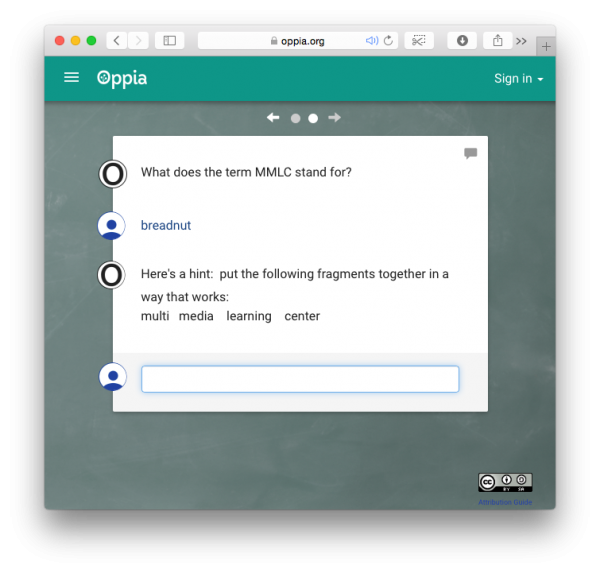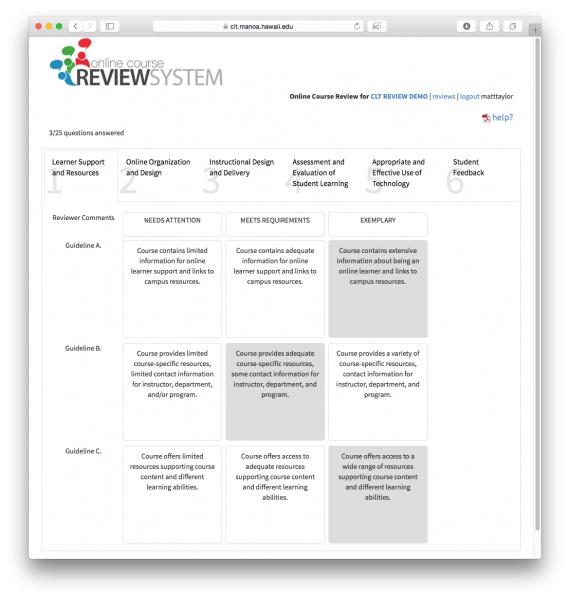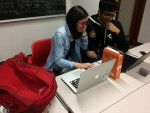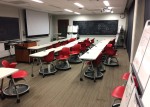So I may be a language technology nerd. But I’m not alone. Each year, some of the geekiest geeks meet at the annual conference of CALICO, the Computer Assisted Language Instruction Consortium. This year, Cecile and I attended and occasionally pushed up our glasses as they would slide down the bridges of our noses — as all nerds do — and tried to fit in.
If there was a take-away message that prevailed, it was this: the future of learning will be increasingly personalized, adaptive, and deeply aware of the learner. Just how deeply aware? Perhaps more than we think. The growing prevalence of smartphones, smart watches, and other monitoring devices combined with an emerging interest in big data and data science could spell a future where learning systems can psychologically and physiologically detect and reproduce the conditions under which individual students learn best.
The vision shared at CALICO, even if more focused on language instruction, is nonetheless a harbinger for the rest of the educational field. In a recent EDUCAUSE article written by Learning Initiative Director Malcolm Brown, “Six Trajectories for Digital Technology in Higher Education,” Brown sees the opportunity of mobile devices in a post-digital-divide era, looks forward to open educational resources and learning spaces, and eyes a future for learning analytics. The language nerds at CALICO obsess over these themes constantly as they imagine the future.
The future, it turns out, is not only talked about in abstract far-away presentations. The future is taking place here at Northwestern, too.
Personalized Education through Adaptive Software
As many educators know, one size does not fit all when it comes to student learning. Benjamin Bloom — the very same psychologist behind the famous Bloom’s Taxonomy — once found that one-to-one education consistently prepared students to perform as well as or better than the highest 2% of performers found in conventional instructional models: a dramatic success. Even if individualized education might be an ideal, it has long been an out-of-reach luxury. Technology continues to narrow the gap through the development of online didactic materials that can customize the learning experience depending upon need.
Among its many courseware projects, the MMLC developed the first version of online instruction tools for French, German, and Spanish in the mid 1990s. These tools instantly improved upon their print text counterparts by offering cost-effective and dynamic access to learning material. At the time, the most jaw-dropping feature was the ability to complete interactive exercises. Multiple choice and fill-in-the-blank questions could be scored and completed online: attempted and re-attempted all while being fully recorded for instructors to later review.
Nearly two decades later, some learning tools have evolved but most are still bound to the same original model of static content and the most basic types of interactive questions.
The next great leap forward is to make learning management systems adaptive: more flexible, more intelligent, better able to assess students’ unique learning needs. Designing adaptive content and systems remains a complex task, requiring careful encapsulation of learning content and large amounts of experiential data to make reasonable predictions. Even the most elaborate algorithms will still have limitations. Amazon — for all its ability to analyze presumed needs based on volumes of consumer purchasing information — still gives me eyebrow-raising recommendations from time to time. Yet, perhaps like a real teacher, they know better what I need than I sometimes do myself.
Interest in adaptive content is growing, as are the number of tools that are marketed as “adaptive.” Carnegie Mellon, already a leader in developing open courseware through its Open Learning Initiative, is now home to a somewhat further commercially evolved platform called Acrobatiq which offers interactive exercises and feedback embedded within the learning content. While highly interactive and engaging, I would not label this learning style as adaptive.
In my view, a better example of a fully adaptive tool is Oppia, a free open-source learning platform that despite a better fulfillment of the word, curiously eschews the term “adaptive.” Authoring content in Oppia does take some getting used to, but the gist of it is that you, as an author, end up writing a the didactic equivalent of a large choose your own adventure novel. For example: First, ask student to add 2+2. Then, If the answer was 4, congratulate; if the answer was something else, explain how you can use your fingers to count; etc.
For a live example: be sure to check out this module on “What does MMLC stand for?”
How far away is this adaptive tutor-like textbook future? Gartner Research, publisher of the popular Hype Cycle for Education, still puts adaptive e-texts within the “peak of inflated expectations” and expects usable maturity in no less than five years. By contrast, Gartner’s assessment puts conventional online course material (e-texts, such as those used in online courses, and open source e-learning applications) in very stabile, productive categories.
Building Better Online Materials, Better Online Courses
Instructional resources and the online courses that they facilitate have grown tremendously over the years, but best practices are still forming. For many just getting started with online courses, it can be difficult to know where to begin, much less how to improve. At CALICO, the University of Hawaii NFLRC (a federally-funded Title VI language resource center) shared a model for evaluating online language courses using a web-accessible scoring rubric. The platform is specific to Hawaii’s infrastructure and setting, but the idea is inspirational and could be a model for helping to evaluate courses at Northwestern.
In the meantime, Sarah’s blog article offers a list of recommendations for creating a great online course experience for students.
Instructional tools aren’t only limited to custom websites and e-books; they now include commercial learning tools and smartphone and tablet apps. For example, in the language learning field, some of the more well known challengers include Rosetta Stone, Mango Languages, and Duolingo all of whom have both web-browser and smartphone/tablet app offerings.
But there are hundreds, if not thousands, more. How can faculty know if an app is worth their time?
Creating an imprimatur — something like a “Good Housekeeping Seal of Approval” — is hard, it turns out. Within CALICO, the Language Teaching and Learning Technologies (LTLT) Special Interest Group had hoped to make it easier to identify great apps by evaluating and approving them. Though a thoughtful and simple idea that meant well, concern for potential legal ramifications stopped the idea early on. For example, a company could sue for damages of lost revenue if felt it’s product was unjustly evaluated. Instead, the group now hopes to eventually build directory of faculty-contributed reviews without passing any kind of official judgement as an organization.
Adaptive and Active Spaces
Discussion among language nerds doesn’t stop with the virtual world. In fact, active learning spaces — configurations that can flexibly accommodate various modes independent and collaborative learning activities — remained a key topic at CALICO.
When talking about active learning classrooms, there are typically two reference models: spaces that offer highly flexible seating options (such as the Library’s Video Theater Classroom) and those that feature small group tables, often each equipped with their own screen called a “learn lab.” In practice, however, many active learning classrooms fall somewhere in-between.
For many at CALICO, the discussion has already moved beyond whether or not active learning spaces are valuable — they are — but how to create them in cost effective ways. Amy Rossomondo from the University of Kansas showcased a newly renovated learn-lab space inspired by SCALE-UP, one of the earliest active learning studies. Kansas, like Northwestern, makes use of online educational materials, such as Acceso, for language courses. The space was then designed to directly support the use of such materials in class activities.
Active Learning Environments have been a topic of growing interest for years, but the best designs require space: lots of space. On Northwestern’s campus, beautifully bounded by a lake on one side and curbed by historically protected structures on the other, we don’t always have the luxury of infinite space and need to think a little more creatively…and cautiously.
Between 2011 and 2015, the Library configured classrooms with popular Node chairs, from Steelcase. These chairs offer 360-degree swivel motion, movable surface tablets, and can be arranged in groups or semi-circular patterns, popular in language courses and discussion sections.
Even more recently, just this past summer, two rooms at the technological institute, F281 and M349, were also redesigned with an eye towards active learning. Each room has been outfitted with movable desks and a simpler version of the Node chair.
It takes more, however, than simply transforming educational spaces to implement active learning; it takes a change in pedagogical approach. NUIT has launched a new initiative, ALE: the Active Learning Environments Faculty Group, to help sustain a growing community of practice. With the major Blackboard-to-Canvas transition now completed, Faculty Support Services can devote more of its energies towards monitoring and supporting the development of new teaching approaches.
The Sensory Future of Education Technology
When it comes to educational technology, CALICO never ceases to provide an inspirational future. Perhaps a computer can never completely match a human’s ability to truly know a learner. But the gap appears to narrow a little bit each year.
Today, a teacher might be able to look at a student and devine if he or she is stressed, frustrated, or disinterested? But how would a computer guess this? A teacher can look at a student and discern from the look of his or her face that the concept isn’t clear and needs to be better explained. But surely a computer can’t see that, can it? — It can!
Karen Price, a language technology consultant and visiting scholar at Boston University, studies the perceptual and sensory technologies that make computers able to both detect and trigger learners’ cognitive-affective states. As she expained at CALICO, “inferring moments when a learner may be bored, frustrated, anxious, or inattentive can inform the development and assessment of online interactions.” This observational data can then “create more natural conversation with virtual agents, triggering their back-channelling, turn-taking decisions, and more appropriate responses.”
Detecting emotional states, it turns out, can be done pretty effectively using a camera. Affectiva uses a computer’s webcam to detect the user’s emotions. Software developers can tap into a database that contains over 11 billion data points gathered from a wide variety of human subjects across different backgrounds and cultures. Microsoft is also getting into the emotional detection game with various device patents, including smart glasses that can detect emotions, and the already released Xbox One Kinect.
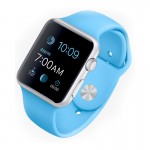
Apple Watch (and other smart watch) data could offer insights into learners’ affective states and habits.
Even more pervasive means of detecting affective states are on the way. Earlier this summer, after the release of the Apple Watch, an Apple engineering team came to present at a NUIT Mobile Meetup. Their presentation offered a deeper dive into its technology and what can be done with frameworks like HealthKit and ResearchKit. During the presentation, it became clear how Apple’s versatile software development kits could go beyond health research to offer detailed insights into certain kinetic and physiological data on learner traits.
But what cognitive-affective state is best? It might seem like learning would best happen when students are the most relaxed, but Price’s survey of relevant studies suggests otherwise. According to Price, “It is better to be frustrated than bored.” Frustration releases dopamine, and in many cases, negative emotions can be associated with progress, particularly in games.
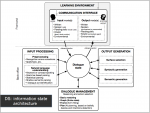
Slide from “Dialog Systems for Language Learning” outlining the design of an improved conversational agent.
Triggering emotions is another exciting realm of research, and is a major part of the work that is being done with Sensitive Artificial Listeners, or SALs, computer agents can be programmed to evoke responses by using different discourse-signaling cues. According to Price, when the SAL causes more frustration for the student, it can surprisingly prolong the engagement of the conversation.
Artificially intelligent tutors have a long way to go before they ever reach the anything close to the versatility of their human counterparts, but the state of the art is constantly advancing. At CALICO, Serge Bibauw and Piet Desmet of the University of Leuven presented a conceptual design for an effective task-based agent that could better engage a learner by providing semantically and pragmatically consistent questions and answers. It sounds wonderful, but is still only a schematic.
The conversational and sensory promise of the HAL 9000 computer may be more than 15 years overdue — perhaps a good thing — but each year it seems we get a little bit closer.
